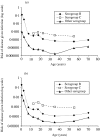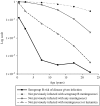The natural history of meningococcal carriage and disease
- PMID: 16238823
- PMCID: PMC2870423
- DOI: 10.1017/S0950268805005339
The natural history of meningococcal carriage and disease
Abstract
The prevalence of Neisseria meningitidis carriage is highest in teenagers and lowest in young children. In contrast, invasive meningococcal disease is most common in young children with a smaller secondary peak in teenagers. Data on carriage and disease were analysed to quantify the risks of infection and disease by age and serogroup. The forces of infection for serogroups B, C, other meningococci and Neisseria lactamica were modelled together with the risk of disease given infection for serogroups B and C, using maximum likelihood to fit the models to the available data. The risk of meningococcal disease given infection declines steeply through childhood and is higher for serogroup C than for serogroup B. The secondary peak in disease in teenagers appears to be explained mostly by increased transmission although there is a suggestion that other factors may also contribute. These analyses provide important insights and may be used to guide further data collection and modelling studies.
Figures





References
-
- Gold R, Goldschneider I, Lepow ML, Draper TF, Randolph M. Carriage of Neisseria meningitidis and Neisseria lactamica in infants and children. J Infect Dis. 1978;137:112–121. - PubMed
-
- Coen PG, Cartwright K, Stuart J. Mathematical modelling of infection and disease due to Neisseria meningitidis and Neisseria lactamica. Int J Epidemiol. 2000;29:180–188. - PubMed
-
- Maiden MCJ, Stuart JM on behalf of the UK Meningococcal Carriage Group. Carriage of serogroup C meningococci one year after meningococcal C conjugate polysaccharide vaccination. Lancet. 2002;359:1829–1830. - PubMed
MeSH terms
LinkOut - more resources
Full Text Sources
Other Literature Sources
Medical

